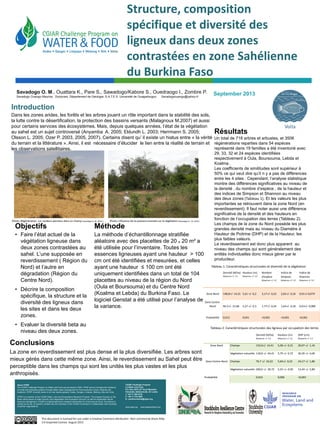
Structure, composition spécifique et diversité des ligneux dans deux zones contrastées en zone Sahélienne du Burkina Faso
- 1. Structure, composition spécifique et diversité des ligneux dans deux zones contrastées en zone Sahélienne du Burkina Faso Savadogo O. M., Ouattara K., Pare S., Sawadogo/Kabore S., Ouedraogo I., Zombre P. Savadogo Ouango Maurice, Doctorant, Département de Géologie, S.A.T.E.S Université de Ouagadougou Savadogoouango@yahoo.fr Introduction Dans les zones arides, les forêts et les arbres jouent un rôle important dans la stabilité des sols, la lutte contre la désertification, la protection des bassins versants (Malagnoux M.2007) et aussi pour certains services des écosystèmes. Mais, depuis quelques années, l’état de la végétation au sahel est un sujet controversé (Anyamba A. 2005; Eklundh L. 2003; Herrmann S. 2005; Olsson L. 2005; Ozer P. 2003, 2005, 2007). Certains disent qu’ il existe un hiatus entre « la vérité du terrain et la littérature ». Ainsi, il est nécessaire d’élucider le lien entre la réalité de terrain et les observations satellitaires. Résultats Un total de 718 arbres et arbustes, et 3506 régénérations reparties dans 54 espèces représenté dans 19 familles a été inventorié avec 29, 33, 32 et 24 espèces identifiées respectivement à Oula, Boursouma, Lebda et Koalma . Les coefficients de similitudes sont supérieur à 50% ce qui veut dire qu’il n y a pas de différences entre les 4 sites . Cependant, l’analyse statistique montre des différences significatives au niveau de la densité , du nombre d’espèce , de la hauteur et des indices de Simpson et Shannon au niveau des deux zones (Tableau 1). Et les valeurs les plus importantes se retrouvent dans la zone Nord (en reverdissement). Il faut noter aussi une différence significative de la densité et des hauteurs en fonction de l’occupation des terres (Tableau 2). Les champs de la zone du Nord possède les plus grandes densité mais au niveau du Diamètre à Hauteur de Poitrine (DHP) et de la Hauteur, les plus faibles valeurs. Le reverdissement est donc plus apparent au niveau des champs qui sont généralement des entités individuelles donc mieux gérer par le producteur. Pictures Partners logoPartners logo CGIAR Challenge Program on Water and Food P.O. Box 2075,127 Sunil Mawatha Pelawatta, Battaramulla, Sri Lanka T: +94 11 288 0143 F: +94 11 278 4083 E: cpwfsecretariat@cgiar.org www.cgiar.org www.waterandfood.org This document is licensed for use under a Creative Commons Attribution –Non commercial-Share Alike 3.0 Unported License August 2013 September 2013 Objectifs • Faire l’état actuel de la végétation ligneuse dans deux zones contrastées au sahel. L’une supposée en reverdissement ( Région du Nord) et l’autre en dégradation (Région du Centre Nord). • Décrire la composition spécifique, la structure et la diversité des ligneux dans les sites et dans les deux zones. • Evaluer la diversité beta au niveau des deux zones. Méthode La méthode d’échantillonnage stratifiée aléatoire avec des placettes de 20 ₓ 20 m² a été utilisée pour l’inventaire. Toutes les essences ligneuses ayant une hauteur > 100 cm ont été identifiées et mesurées, et celles ayant une hauteur ≤ 100 cm ont été uniquement identifiées dans un total de 104 placettes au niveau de la région du Nord (Oula et Boursouma) et du Centre Nord (Koalma et Lebda) du Burkina Faso. Le logiciel Genstat a été utilisé pour l’analyse de la variance. About CPWF The CGIAR Challenge Program on Water and Food was launched in 2002. CPWF aims to increase the resilience of social and ecological systems through better water management for food production (crops, fisheries and livestock). CPWF currently works in six river basins globally: Andes, Ganges, Limpopo, Mekong, Nile and Volta. CPWF is a member of the CGIAR Water, Land and Ecosystems Research Program. The program focuses on the three critical issues of water scarcity, land degradation and ecosystem services, as well as sustainable natural resource management. CGIAR is a global agriculture research partnership for a food secure future. Its science is carried out by the 15 research centers who are members of the CGIAR Consortium in collaboration with hundreds of partner organizations. Conclusions La zone en reverdissement est plus dense et la plus diversifiée. Les arbres sont mieux gérés dans cette même zone. Ainsi, le reverdissement au Sahel peut être perceptible dans les champs qui sont les unités les plus vastes et les plus anthropisés. Photo: Influence de la pression animale sur la végétation (Savadogo O. M. 2012)Photo: Régénération sur cordons pierreux dans un champ (Savadogo O. M. 2012.) Tableau 1: Caractéristiques structurales et diversité de la végétation Tableau 2: Caractéristiques structurales des ligneux par occupation des terres Densité (N/ha) Moyenne +/- S.E Hauteur (m) Moyenne +/- S.E Nombre d’espèce Moyenne +/- S.E Indice de Simpson Moyenne +/- S.E Indice de Shannon Moyenne +/- S.E Zone Nord 148,8+/- 14,31 5,61 +/- 0,2 3,17+/- 0,22 2,62+/- 0,16 0,91+/-0,079 Zone Centre- Nord 94,3+/- 15,68 5,27 +/- 0,3 1,77+/- 0,24 1,63+/- 0,18 0,43+/- 0,089 Probabilité 0,012 0,041 <0,001 <0,001 <0,001 Densité (N/ha) Moyenne +/- S.E Hauteur (m) Moyenne +/- S.E DHP (cm) Moyenne +/- S.E Zone Nord Champs 152,0+/- 14,41 5,58 +/- 0,21 20,07 +/- 1,16 Végétation naturelle 118,8 +/- 44,41 5,79 +/- 0,72 30,39 +/- 4,06 Zone Centre-Nord Champs 76,7 +/- 16,22 5,64+/- 0,33 24,17 +/- 1,86 Végétation naturelle 200,0 +/- 39,72 3,23 +/- 0,50 12,44 +/- 2,80 Probabilité 0,016 0,006 <0,001
